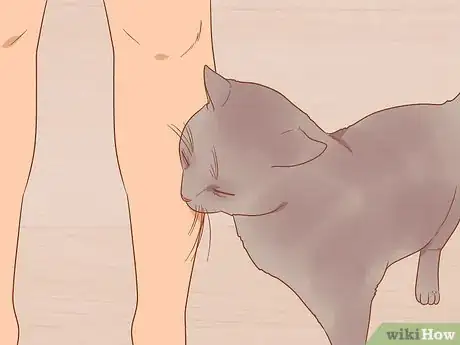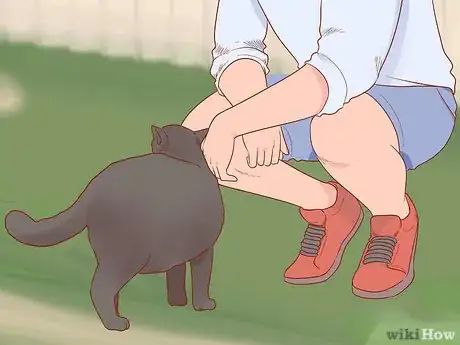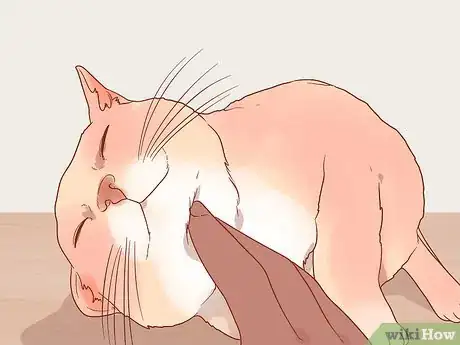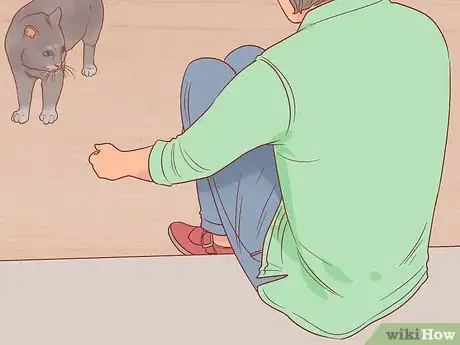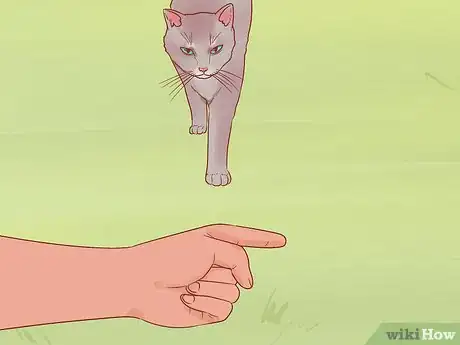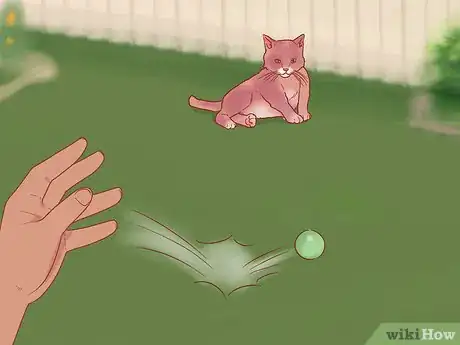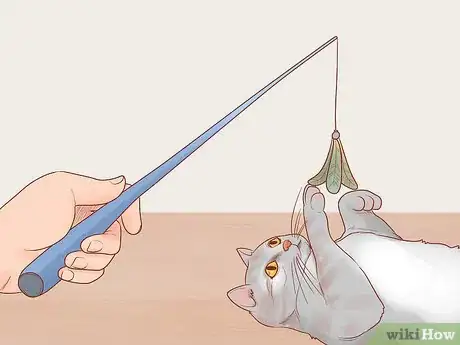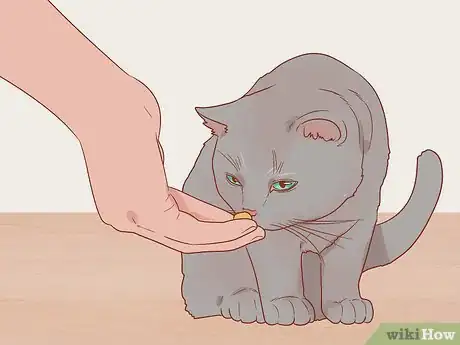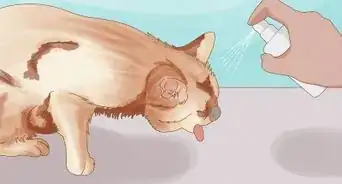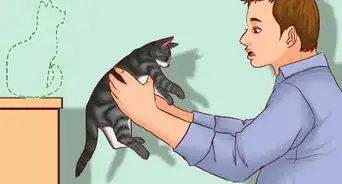This article was co-authored by Deanne Pawlisch, CVT, MA. Deanne Pawlisch is a Certified Veterinary Technician, who does corporate training for veterinary practices and has taught at the NAVTA-approved Veterinary Assistant Program at the Harper College in Illinois and in 2011 was elected to the board of the Veterinary Emergency and Critical Care Foundation. Deanne has been a Board Member of the Veterinary Emergency and Critical Care Foundation in San Antonio, Texas since 2011. She holds a BS in Anthropology from Loyola University and an MA in Anthropology from Northern Illinois University.
This article has been viewed 22,804 times.
Each cat is different, so greeting them can be a challenge. If you know a cat is friendly, wait for it to approach, get down to its level in a comfortable spot, let it sniff you, and pet it. To greet shy cats, kneel, extend a finger, and let them approach you. If they are not responsive, do not push. Ignore them and keep your distance until your presence is more comfortable to them. Use treats, toys, or games to encourage a shy cat to greet you if all else fails.
Steps
Greeting a Friendly Cat
-
1Wait for the cat to approach. When you are near a cat that you are friendly with (e.g. your own, or a close friend's cat) wait for it to approach you. Even cats that are normally friendly have days when they do not wish to be disturbed. Wait for it to demonstrate signs of affection (e.g. rubbing up against your leg) before greeting it.[1]
-
2Move to a comfortable area. To properly greet a friendly cat, move to an area where you can settle in to pet, play, or cuddle the cat. Move away from the doorway, which could provide an unplanned exit for an excited cat. A cat will develop positive associations with whatever happy greeting spot you choose.[2]Advertisement
-
3Get down to the cat's level. Sit or kneel on the ground to allow the cat to greet you on its own level. The cat may want to rub its nose on you, which is a bonding exercise and a sign of affection. Your cat may also be comfortable greeting you from a high spot (e.g. the top of the couch, a tall windowsill).[3]
- If the cat wants to rub its nose on you, don't let it rub it's nose on your face on the first meeting, as this can be dangerous for you if the cat gets upset.
-
4Pet the cat. Once a cat is comfortable with you, feel free to pet it gently. Start with the back and neck, spots that most cats enjoy being pet. Avoid petting the cat's tail, which is a sensitive area and may evoke a negative reaction.[4]
-
5Blink slowly at the cat to show it you're friendly. Cats blink slowly to show affection, and you can do the same thing to show the cat that you're a friend. If the cat also blinks slowly and seems calm, then you can continue the interaction.[5]
- These are also called "cat kisses."
Greeting a Shy Cat
-
1Kneel or sit at the cat's level. When you enter a room with a cat, or if a cat enters a room you are in, do not approach it. Instead, kneel down or sit at the cat's level. This will ensure that the cat doesn't see you as threatening or aggressive.[6]
-
2Extend your finger. Once you are at the cat's level, extend your index finger out in front of you. Do this slowly and calmly, and do not get too close to that cat in doing so. The aim is to give the cat the feeling that it has control in the situation, and can decide whether or not to approach you.[7]
-
3Wait for the cat to approach. Hold your position and wait for the cat to approach you. It will likely sniff your finger first, a move that mimics cats' nose-to-nose greeting to each other. Allow the cat to sniff your finger and rub against it if it wishes to.[8]
-
4Respect the cat's limits. If the cat does not respond to your gesture, or moves away after sniffing your finger, leave it alone. Respect the cat's space and do not attempt to approach it or extend your finger again. Pushing an unwilling cat into an interaction can result in undesirable reactions such as:[9]
- Hissing
- Growling
- Intense staring
- Running away from you
- Swatting at you
- Scratching
-
5Try playing with toys as an icebreaker. If a cat is especially shy, try introducing yourself via play. Toss a toy for the cat to chase, making sure to throw it away from both you and the cat to create a neutral playing zone. This way, the cat will comfortable playing and might warm up to you during the game.[10]
-
6Use a wand toy to draw it closer. A neutral way to encourage a cat to approach you is to dangle a wand toy near it. If the cat is interested, this will allow it to approach you with a goal and interest outside of you. Playing with the wand toy may relieve stress and apprehension and make the cat feel more at ease near you.[11]
- If the cat demonstrates any signs of distress (e.g. hissing), put down the wand toy and give the cat some space.
-
7Ignore the cat. If a cat is apprehensive around you, do your best to ignore it while you are in its presence. Keep your distance and avoid any eye contact with it. Your presence, without the threat of a forced interaction, will likely become more familiar and less threatening with time.[12]
-
8Be cautious about petting. When a shy cat finally starts to warm up to you, be careful about how you pet it. Pet it on the neck, head, or side in a gentle manner. Do not offer any resistance if the cat moves away from you or re-positions itself.
-
9Offer the cat treats. With its owner's permission, offer a shy cat treats to coax it into an introduction. This will give the cat an incentive for greeting you and create a positive association with you in its mind. Be calm and gentle during the interaction.
Warnings
- Always avoid eye contact, which cats can perceive as an attempt to provoke them.⧼thumbs_response⧽
- Avoid standing or bending over a cat, which can be seen as aggressive or dominating.⧼thumbs_response⧽
References
- ↑ http://www.cathealth.com/how-and-why/greeting-a-cat
- ↑ http://www.cathealth.com/how-and-why/greeting-a-cat
- ↑ http://www.cathealth.com/how-and-why/greeting-a-cat
- ↑ http://www.pawculture.com/tips-advice/bonding/how-to-cuddle-a-cat-the-ultimate-guide/
- ↑ http://www.catster.com/lifestyle/cat-behavior-cats-show-affection-people-aloof-unemotional-myth
- ↑ http://www.catbehaviorassociates.com/greeting-a-cat-using-proper-cat-etiquette/
- ↑ http://www.catbehaviorassociates.com/greeting-a-cat-using-proper-cat-etiquette/
- ↑ http://www.cathealth.com/how-and-why/greeting-a-cat
- ↑ http://www.cathealth.com/how-and-why/greeting-a-cat
About This Article
Although every cat is different, the best way to greet most cats is to let it approach you first. You can make the cat feel more comfortable by getting down on its level and extending your index finger out in front of you. The cat will most likely respond by rubbing its nose on you, but if it's particularly shy, you may want to play with its favorite toys as an icebreaker. Either way, once the cat seems comfortable, you can try gently petting it on the back and neck, which is where most cats enjoy being pet. For more tips from our Veterinary co-author, like how to tell if a cat wants to be left alone, scroll down!
